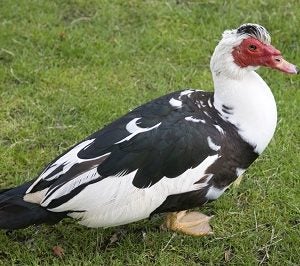Lizard penises evolve much faster than the rest of the lizard, according to new research in the Caribbean. The study provides some confirmation for a long-standing assumption in evolutionary biology, that when fertilization is internal, male genitals will evolve rapidly to keep up with morphological changes in female genitalia. The rapid evolution fits in with a larger hypothesis known as sexual conflict, in which females try to evolve mechanisms in order to control copulation, and males evolve countermeasures.
It’s tempting to make jokes, but there is a surprisingly large body of work regarding penis evolution. (A search in JSTOR for penis evolution returned 5000 results!) One important paper on the subject of sexual conflict was written by Patricia Brennan and colleagues in Proceedings: Biological Sciences. A lot of the classic research on sexual conflict has been done in waterfowl, which are known for oddly shaped and freakishly large penises relative to their body size (up to half the body length in some species). Many species of ducks are known for rather violent mating, in which one or more males will attempt to force themselves on a female. And you thought ducks were cute. Sorry.

In their outwardly bizarre but well-designed experiment, Brennan and colleagues tested the sexual conflict hypothesis by coaxing male Muscovy ducks (drakes) to mount differently shaped, oiled glass tubes. This was possible because the drakes in question were practiced sperm donors—yes, sperm donors, trained to provide specimens for artificial insemination—who were allowed to get themselves in the mood with a female before quickly being transferred to the tube. The procedure is a fair approximation of a drake forcing itself on a female. Before you cringe too much, the researchers also determined that duck penises become erect in less then a second and remain flexible when erect, so the procedure is actually quick and painless for the duck.
The results? The drakes had the hardest time entering the tube that was actually shaped like female Muscovy genitalia (a clockwise spiral, in case you are interested). The results suggest that yes, female ducks do physiologically attempt to prevent forcible mating. Presumably, it would not be quite as difficult if the female consented to the mating. The study showed that sexual conflict as an evolutionary driver is reflected in actual physiology, as prior to Brennan’s experiment it was all theoretical. Nobody actually knew how duck copulation worked. Now that we have proof of rapid evolution in male genitalia in several species, evidence for sexual conflict is quite strong.
Remember, this hypothesis applies to any species with internal fertilization, not just waterfowl or lizards, so yes, humans may also be subject to this process. There are many stereotypes about letting sex cloud the brain, but it may be worse than that. Sex may be determining not just our actions, but our very form and our development as a species. For the moment, let’s be content that we aren’t ducks.







